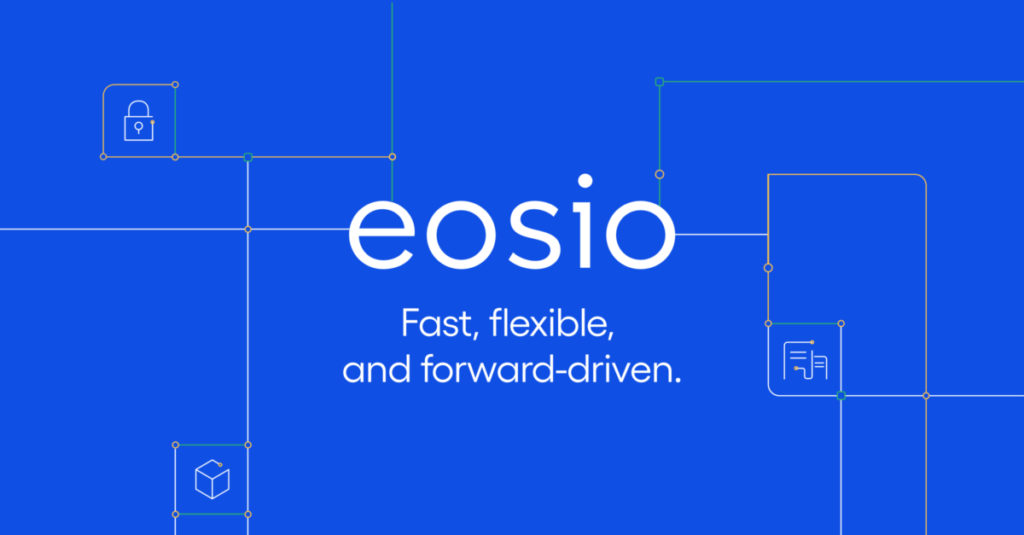- A wide range of tools and educational resources for developers to help them quickly build functional dApps.
- Zero gas fee for the end-users.
- Highly efficient blockchain capable of processing a large number of transactions per second.
- A modular approach and parallel execution, for higher efficiency.
- Highly scalable and designed for mass adoption.
- Amongst the top 100 cryptocurrencies in terms of market cap.
- Industry-leading transaction speeds.
- Backed by Daniel Larimer, the brains behind BitShares, Steem blockchain and the delegated Proof of Stake consensus mechanism.
- Vulnerable to monopolistic governance owing to high centralization.
- Ran into issues with SEC in 2021; had to pay $24 million as a penalty.
- Less popular as compared to other smart contract platforms like Binance Smart Chain, Solana, and Ethereum.
📝Source Code – 🏠Website – 📈Chart 📱 Twitter
EOS in a nutshell
EOS is the native coin of the EOS blockchain platform. The cryptocurrency is required for accessing and using the EOS network, which essentially allows developers to create, deploy and run efficient decentralized applications (dApps). What sets EOS apart is the scalability potential it offers and the enormity of its decentralized enterprise.
With a market cap of close to $2.67 billion at the time of writing, EOS is ranked #51 amongst the top 100 cryptocurrencies (based on the market cap). There are over 300 dApps running on EOS. Some of the popular ones among them include PRA Candybox (Utility), Upland (Game), Defibox (Exchange), DFS Network (Finance), SportBet (Gambling), WhaleEx (Exchange), and Newdex (Exchange).
Tokenomics
Block.one had a very successful ICO (Initial Coin Offering) launch for EOS in June 2017 which lasted for almost a year and generated $4.1 billion in total.
1 billion ERC-20 tokens were distributed as a part of this launch, of which 90% were allocated to the investors and the remaining 10% to the founders. However, the founders are going to receive their share in a staggered manner, over a 10-year time period.
At the time of reporting, there were 977 million EOS in circulation, with no cap on the total supply. The EOS supply increases at an annual inflation rate of 1% (as against 5% previously). Block.one has recommended increasing this inflation rate to 1.3% – 3.8%, so as to offer a higher incentive to the block producers.
At least 32% of the total inflationary rewards are distributed amongst block producers while the remaining 68% (at most) are shared by the stakers.
Has EOS been audited and doxed?
Yes, the EOS coin was audited by Clifford Chance. Block.one is also quite active when it comes to publishing documentation regarding the developments in the EOS blockchain ecosystem. They regularly make media announcements via press releases on the EOS official website and are also active on multiple social media portals.
Trust & Fairness: 4
Exchanges & Swaps: 4
Tokenomics: 5
Community: 5
Overall Rating: 4.5
Detailed review of EOS (EOS)
EOS came into being in June 2018. The blockchain was developed by a company named Block.one, founded by Daniel Larimer, a software programmer by profession, and Brendan Blumer, a serial entrepreneur.
Larimer is the same person who is also behind other popular crypto ventures like the Steem blockchain and BitShares crypto trading platform. He’s one of the brains behind the creation of delegated Proof of Stake (DPos) consensus mechanism too. While Blumer continues to be associated with Block.one as its CEO, Larimer functioned as its CTO till January 2021.
In the EOS whitepaper, developers talk about introducing a dApp development platform capable of processing hundreds of thousands of transactions per second in a highly secure manner. EOS.IO, the operating system that forms the backbone of the EOS blockchain was conceptualized to become the ultimate OS for decentralized applications.
The overall goal of EOS is quite simple, that is to make blockchain tech adoption extremely easy and straightforward for programmers, by ensuring that the network stays easier to use than competitors at all times. Resultantly, a wide range of tools and educational resources are offered to developers interested in creating functional dApps in the quickest manner possible.

EOS is also aimed at optimizing the business and user experience. Although the network attempts to deliver the highest security and least friction to the end-users, it is also positioned towards enterprises keen on a higher level of compliance and flexibility.
The EOS blockchain is capable of efficiently running hundreds of dApps simultaneously, even when they’re being actively used by a large number of people. A modular approach and parallel execution are responsible for helping it maintain this level of efficiency.
The network features a comprehensive authentication system that enables developers to program user accounts with preset permission levels directly from the EOS panel itself. In addition, businesses can share database access with anyone on the EOS network. Not just that, companies can even download, store and maintain the data offline, in a local environment, for as long as they desire.
Another crucial tool that works as a differentiator for EOS is the provision of cloud storage in the EOS development package. EOS.IO offers developers both cloud storage as well as server hosting, thus making it one of the most sought-after dApp protocols in the market today. As a result, with everything available at their fingertips, programmers can focus on development-related activities rather than being concerned about hardware limitations. EOS comes with integrated advanced analytics as well that keep developers updated about their dApps performance.
The network employs a delegated Proof of Stake (DPoS) consensus algorithm to secure its network. The concept was actually conceived by Dan Larimer himself and it aims to solve some of the commonly known issues faced by the Proof of Stake (PoS) and Proof of Work (PoW) systems. As per delegated PoS system, the EOS token holders get the right to vote for representatives who validate EOS transactions and produce new blocks.
There are 21 block producers in the EOS project, and they can change from time to time. Delegating the transaction validation and block production task to a small group of people enables speeding up the blockchain operations and lowering the transaction costs.
As against other dApp development platforms, developers need to only hold EOS coins, and need not spend them, to be able to use the EOS blockchain’s resources and to develop, deploy and run dApps. Coin holders who have no interest in running any apps can rent or allocate their bandwidth to people who need it.
As per developers, EOS comes with the security level of Bitcoin and ease of programming comparable to Ethereum. In terms of scalability, it’s capable of surpassing even Ripple. Although many have dubbed EOS as the potential ‘Ethereum killer,’ realistically speaking, it has a lot of ground to cover before having any real chance of displacing Ethereum as the best dApp platform at the top.
While EOS has garnered praise from plenty of quarters, there have also been concerns of it being more centralized than many of its counterparts. There was a research paper published by Binance which revealed that its network structure is vulnerable to monopolistic governance, with rich people amassing a large number of votes for themselves.
Where to buy EOS
You can purchase EOS from various decentralized and centralized crypto exchange platforms. It’s common for exchanges to pair EOS with other popular crypto coins like Bitcoin (BTC), Ethereum (ETH), and Binance Coin (BNB) to facilitate easy swaps. Some of the well-known exchange portals that list EOS include Binance, Gate.io, Coinbase, Bitfinex, Huobi Global, Kraken, Bittrex, and KuCoin.
Decentralized exchanges like PancakeSwap make EOS purchases even easier by enabling you to directly connect your EOS wallet to the platform, and selecting the appropriate crypto coin for exchange. Going the decentralized exchange route offers greater anonymity, quicker transaction, and overall easier purchase.
Another commonly used means to buy EOS in the market is through brokerage portals. Brokers act as middlemen between buyers and the market. Considering the huge popularity EOS enjoys today, it would be difficult to find a crypto brokerage site worth its name that doesn’t list EOS as one of the available cryptocurrencies. Most of these portals facilitate the easy purchase of EOS with fiat currencies, through multiple payment methods including credit card, debit card, and bank transfers.
It’s possible to acquire EOS with cash too, using peer-to-peer (P2P) trading platforms, or indirectly through Bitcoin ATMs.
However, please bear in mind that the possibility of buying EOS in your country will depend greatly on your local crypto regulations.
What can you do with EOS?
Hodl as a long-term investor: There are many people who simply buy EOS and hold on to the coin for the long term, to register gains from its price appreciation. As mentioned earlier, you can even rent out or allocate your EOS holdings to others who can directly use and benefit from its blockchain’s resources.
Stake EOS: You can even stake your EOS coins per the blockchain’s Delegated Proof of Stake consensus mechanism and earn more EOS as a reward.
Swap EOS with other coins: There are many cryptocurrency exchanges where you’ll be allowed to swap your EOS coins with other crypto coins, at the listed exchange rate. It’s a pretty straightforward process as also detailed below.
How to swap EOS with other altcoins?
In order to swap your EOS coins with another altcoin, simply head to any well-known decentralized crypto exchange of your choice and connect your wallet to the platform. Thereafter, specify the amount of EOS you’d like to swap (after accounting for the transaction fee) and process the transaction. The swapped coins will arrive in the same wallet.
How to buy EOS?
The majority of the people use either a centralized or a decentralized crypto exchange to buy EOS. There are no registration or KYC (Know Your Customer) formalities involved in decentralized exchanges (DEXs). Additionally, they are extremely easy to use. We have already covered the coin swap process for DEXs, above.
Now coming to the purchase of EOS on centralized exchanges, you’ll first need to locate one which is well-recognized and regulated by a leading financial authority. Doing so will ensure that your funds/investments will be safe and you’ll have someone to turn to in the event of any mishap. A well-regulated crypto exchange will require you to register an account with them and fulfill certain KYC requirements as per international Countering the Financing of Terrorism (CFT) and Anti-Money Laundering (AML) laws.
Below are listed the steps to buy EOS on a centralized crypto exchange:
- Visit the exchange website and check if EOS is listed with them. If yes, click the ‘Register’ button to get started.
- To open an account, you’ll need to select your country of residence and input your name, phone number, email id, and preferred password.
- Agree to the terms and conditions by clicking on the provided button.
- You’ll either get a verification message on the screen or receive verification instructions via email. Upload scanned copies of documents like a government-issued photo ID and a separate proof of address. Some exchanges may also require you to upload your picture holding these documents, in addition. While this process may seem like a pain to many, it is necessary to keep bad elements at bay.
- The exchange will activate your account after you’ve completed the above formalities. You’ll then be able to deposit funds in the form of fiat currency or crypto coins (supported by the exchange) to buy EOS. Most exchange portals permit bank transfers, credit/debit cards, and third-party payment processors as valid payment methods for fiat deposits.
- Once the funds show up in your account, you can use an appropriate trading pair, for example, EOS/USD, EOS/BTC, EOS/USDT, and EOS/BNB, to buy EOS.
Upcoming Events/Launches
As per a recent post shared by Daniel Larimer on Medium.com, the EOSIO code repository will be forked into a new codebase called Mandel (short form of Mandelbrot), whose first version will be Mandel 3.0. The final release of Mandel 3.0 is expected by March 2022. Some of the noteworthy features of this hard fork will be: configurable WASM limits, Contract Pays for easy-to-use dApps, and enhanced configurable blockchain Params.
EOS Price
EOS was trading at $2.80 per coin at the time of writing (Source: CoinMarketCap). Its all-time high price was $22.89, reported on April 29, 2018. The all-time low on the other hand was $0.4802 on Oct 23, 2017. If we compare the ATH and ATL price figures of EOS, we arrive at returns of around 4767% which aren’t bad by any standards. You can check the current trading price of EOS on portals like CoinMarketCap and CoinGecko.



